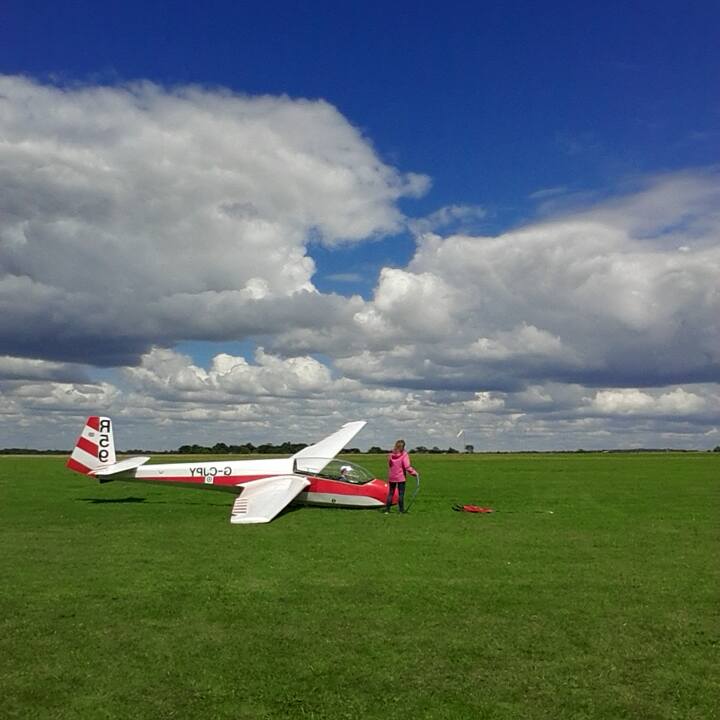What to bring?
- Photo ID – You are required to bring a government issued photographic ID (passport, driving licence or BRP) in order to be allowed onto the airfield (which operates on a military base). Please note this will still be required on all subsequent visits.
- Appropriate clothing – Regardless of the time of year, you will need some good waterproof boots because the airfield is almost always muddy. During the winter months; coats, jumpers, hats, scarves, gloves are all necessary. Do not underestimate how cold you can get when you spend 8 hours stood in an open field! During summer; sun cream, sun hat (ideally a soaring hat).
- Food and water – there are not always any food or drinks being served, so make sure you bring plenty of water (especially during summer) and any food you may want to eat.
- Money – You may want to bring some loose change for food (if it’s being served) and drinks in the bar after flying has ceased. You should also bring a debit or credit card to pay your flying fees.
- Logbook – If you have one, don’t forget to bring your logbook to keep track of your flights. If you don’t have one yet, ask to buy one next time you’re on the airfield.
- Camera – If you ask your instructor, they will let you take pictures from the air during your flights.
Where do we meet?
You should meet us outside the Portland Building (lakeside) at 7:45am on Saturday or Sunday (depending on the day you’re flying). We will leave by 8:00am, so if you’re running late please let the duty committee member (DCM) know as soon as possible.
If the weather is looking terrible, we will normally try to cancel the trip in advance, or possibly on the morning. It’s always frustrating when this happens but it’s just part of the sport. If you are a regular member (or just very keen!), we expect you to come along regardless of weather to help carry out essential maintenance and cleaning of our gliders.
On the airfield…

When you arrive at the airfield for the first time, you may find it very overwhelming. There will be people rushing around, pushing gliders, carrying parachutes and driving vehicles all over the place. What you’re witnessing is actually the very well practised routine of preparing the gliders and airfield for a days worth of flying. All of this is organised by the Duty Instructor (DI) and the Duty Pilot (DP). The Duty Instructor is in charge of everything that happens on the airfield, they are there to see that everything is done safely. Their assistant, the Duty Pilot, will handle the general organisation of the airfield, including pairing instructors to students and deciding who gets to fly next.
The first thing that you will do is receive a safety brief from one of our committee members. It is important that you understand the safety brief and follow guidelines to avoid any accidents. The chances are that if somebody sees you breaking these guidelines, they will let you know about it straight away (and more often than not, in a rather blunt fashion). Should you be on the receiving end of a harsh rebuke about a safety issue, please do not take it personally – the RAF culture is strong on safety but less so on sensitivity!
On a typical weekend day there will be a dozen members of Cranwell Gliding Club at the launch point and ten or so university members. The airfield is run on a voluntary basis, and it is important to be seen to be helping out whenever possible. This keeps the flying cheap for everyone. There are some things you will be able to help out with straight away, some that you can do after being shown how, and some which you need a bit of experience at the airfield before you can help with (for example, only solo pilots can drive the winch or perform a daily inspection on the gliders before they fly). Nobody expects you to do anything you haven’t done before – in fact you shouldn’t do anything without being shown how first – ask if in doubt! There are always people around who will show you the ways in which you can help out.
Obviously, there are more pilots than gliders, so you will have to wait your turn to fly. Flights are usually done in sets of 3, unless you have a much longer aerotow which will be a single flight.
Once everyone has done all the flying they need to (often you will get a chance to have a second set of flights during the day, once everyone has had one), things will start to get put away. As soon as the hanger doors are shut, everyone can begin to relax and unwind in the bar. It’s important to remember to pay your flying fees at this time!